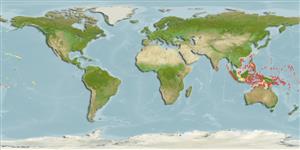Klassifizierung / Names
Namen | Synonyme | Catalog of Fishes(Gattung, Arten) | ITIS | CoL | WoRMS | Cloffa
>
Kurtiformes (Nurseryfishes, cardinalfishes.) >
Apogonidae (Cardinalfishes) > Apogoninae
Etymology: Taeniamia: Name from feminine Latin noun 'taenia' meaning ribbon or band; and feminine Greek noun 'Amia' meaning a fish, often used with cardinalfishes genera. Here as Taeniamia referring to the vertical wide bars and near vertical to curved narrow bars as lines on most of the species in this genus..
More on author: Lachner.
Environment: milieu / climate zone / depth range / distribution range
Ökologie
seewasser riff-verbunden; tiefenbereich 0 - 33 m (Ref. 54391), usually 0 - 15 m (Ref. 54391). Tropical; 30°N - 15°S
Western Pacific: Sumatra to Tonga and Vanuatu, north to the Ryukyu Islands and south to Australia; also Palau and Mariana Islands in Micronesia.
Size / Gewicht / Alter
Maturity: Lm ? range ? - ? cm
Max length : 11.0 cm TL Männchen/unbestimmt; (Ref. 9710)
Rückenflossenstacheln (insgesamt): 7; Rückenflossenweichstrahlen (insgesamt): 9; Afterflossenstacheln 2; Afterflossenweichstrahlen: 14 - 19. Diagnosis: Dorsal rays VII,9; anal rays 11,14-19 (usually 16-18); pectoral rays 14 (rarely 13 or 15). Lateral-line scales 25 + 3-5. Median predorsal scales 5-6 (usually 6). Gill rakers 5-7 + 15-18 (total, 20-24). Body depth 2.3-2.85 in SL, and body width 2.3-2.7 in the depth; eye diameter 2.7-3.1 in head length; first dorsal spine 2.0-2.9 in second spine; second dorsal spine 2.1-2.6, and third dorsal spine 2.2-2.7 in head length; spine of second dorsal fin 2.3-2.6, and second anal spine 2.5-2.9 in head length; pelvic-fin length 4.3-5.3, and caudal-peduncle length 4.9-5.9 in SL. Distance from insertion of pelvic spine to anal-fin origin 4.2-5.5 in SL. Posterior preopercular edge fully serrate or nearly so; serrae on upper part usually minute, rarely absent; ventral preopercular edge serrate on posterior two-thirds. Scaly sheath along anal-fin base well developed (Ref. 54391).
Occurs in inshore reefs of bays or lagoons, typically hovering in small groups in the recesses of caves (Ref. 1602, 48635).
Life cycle and mating behavior
Geschlechtsreife | Fortpflanzung | Ablaichen | Eier | Fecundity | Larven
Mouthbrooders (Ref. 240). Distinct pairing during courtship and spawning (Ref. 205).
Gon, O. and J.E. Randall, 2003. Revision of the Indo-Pacific cardinalfish genus Archamia (Perciformes: Apogonidae), with description of a new species. Indo-Pac. Fish. (35):49 p. (Ref. 54391)
IUCN Rote Liste Status (Ref. 130435)
Bedrohung für Menschen
Harmless
Nutzung durch Menschen
Mehr Information
ReferenzenAquakulturAquakultur ProfilZuchtlinienGenetikElectrophoresesVererbbarkeitKrankheitenVerarbeitungNutrientsMass conversion
PartnerBilderStamps, Coins Misc.LauteCiguateraGeschwindigkeitSchwimmstilKiemenoberflächeOtolithsGehirngrößeSehfähigkeit
Tools
Zusatzinformationen
Download XML
Internet Quellen
Estimates based on models
Preferred temperature (Ref.
123201): 26.9 - 29.3, mean 28.7 °C (based on 1370 cells).
Phylogenetic diversity index (Ref.
82804): PD
50 = 0.5001 [Uniqueness, from 0.5 = low to 2.0 = high].
Bayesian length-weight: a=0.01479 (0.00690 - 0.03171), b=3.09 (2.91 - 3.27), in cm total length, based on LWR estimates for this (Sub)family-body shape (Ref.
93245).
Trophic level (Ref.
69278): 3.5 ±0.5 se; based on size and trophs of closest relatives
Widerstandsfähigkeit (Ref.
120179): hoch, Verdopplung der Population dauert weniger als 15 Monate. (Preliminary K or Fecundity.).
Fishing Vulnerability (Ref.
59153): Low vulnerability (10 of 100).
Nutrients (Ref.
124155): Calcium = 132 [67, 216] mg/100g; Iron = 0.935 [0.540, 1.614] mg/100g; Protein = 18.7 [17.5, 19.8] %; Omega3 = 0.131 [0.075, 0.224] g/100g; Selenium = 31.4 [16.2, 60.9] μg/100g; VitaminA = 57.9 [16.9, 202.4] μg/100g; Zinc = 1.59 [1.04, 2.35] mg/100g (wet weight);
